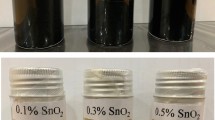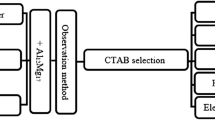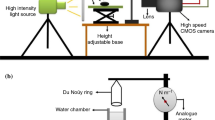Abstract
Oxide and CNT nanoparticles were prepared and characterized to understand the effect of disaggregation on the thermal conductivity and viscosity of nanofluids through experimental and theoretical analysis. The oxide nanofluids contained spherical oxide nanoparticles, including Al2O3, CuO, and ZnO, and the CNT nanofluids contained multiwalled carbon nanotubes in deionized water. Aggregations of numerous oxide nanoparticles were observed from Dynamic Light Scattering and Scanning Electron Microscopy. Ultrasonication and centrifugation were made to mechanically separate the agglomerated nanoparticles. Nanoparticle size decreased by 15% with one hour sonication for oxide nanoparticles with diameters in the range of 10∼100 nm and centrifugation disaggregation methods showed 36% and 40% reduction in size for the Al2O3/DI water and the CuO/DI water nanofluid, respectively. A chemical based disaggregation method for the oxide nanoparticles using surfactants and changing the pH were performed. A significant size reduction was achieved with a pH value of 4.2. The effects of agglomeration on the thermal conductivity and viscosity of nanofluids were examined based on the three-level homogenization model. The use of hydrodynamic particle nanofluid shows an effective thermal conductivity and viscosity, when the aspect ratio of the particle aggregation is below 4.1 and 2.5 for CuO/water and Al2O3/water nanofluid, respectively.
Similar content being viewed by others
Abbreviations
- SEM:
-
Scanning Electron Microscope
- DLS:
-
Dynamic Light Scattering
References
Kabelac, S. and Kuhnke, J. F., “Heat Transfer Mechanisms in Nanofluids — Experiments and Theory,” Proc. of International Heat Transfer Conference, pp. 30, 2006.
Eastman, J., Choi, U., Li, S., Thompson, L., and Lee, S., “Enhanced Thermal Conductivity through the Development of Nanofluids,” Proc. of Materials Research Society Symposium, Vol. 457, pp. 3–12, 1997.
Lee, P. H., Nam, J. S., Li, C., and Lee, S. W., “An Experimental Study on Micro-Grinding Process with Nanofluid Minimum Quantity Lubrication (MQL),” Int. J. Precis. Eng. Manuf., Vol. 13, No. 3, pp. 331–338, 2012.
Das, S. K., Putra, N., Thiesen, P., and Roetzel, W., “Temperature Dependence of Thermal Conductivity Enhancement for Nanofluids,” Journal of Heat Transfer, Vol. 125, No. 4, pp. 567–574, 2003.
Xuan, Y. and Li, Q., “Heat Transfer Enhancement of Nanofluids,” International Journal of Heat and Fluid Flow, Vol. 21, No. 1, pp. 58–64, 2000.
Zhang, X., Gu, H., and Fujii, M., “Effective Thermal Conductivity and Thermal Diffusivity of Nanofluids Containing Spherical and Cylindrical Nanoparticles,” Experimental Thermal and Fluid Science, Vol. 31, No. 6, pp. 593–599, 2007.
Godson, L., Raja, B., Mohan Lal, D., and Wongwises, S., “Enhancement of Heat Transfer using Nanofluids — an Overview,” Renewable and Sustainable Energy Reviews, Vol. 14, No. 2, pp. 629–641, 2010.
Ho, C. J., Liu, W. K., Chang, Y. S., and Lin, C. C., “Natural Convection Heat Transfer of Alumina-Water Nanofluid in Vertical Square Enclosures: an Experimental Study,” International Journal of Thermal Sciences, Vol. 49, No. 8, pp. 1345–1353, 2010.
Kleinstreuer, C. and Feng, Y., “Experimental and Theoretical Studies of Nanofluid Thermal Conductivity Enhancement: a Review,” Nanoscale Research Letters, Vol. 6, No. 1, pp. 1–13, 2011.
Prasher, R., Phelan, P. E., and Bhattacharya, P., “Effect of Aggregation Kinetics on the Thermal Conductivity of Nanoscale Colloidal Solutions (Nanofluid),” Nano Letters, Vol. 6, No. 7, pp. 1529–1534, 2006.
Hong, K. S., Hong, T. K., and Yang, H. S., “Thermal Conductivity of Fe Nanofluids Depending on the Cluster Size of Nanoparticles,” Applied Physics Letters, Vol. 88, No. 3, Paper No. 031901, 2006.
Lee, J., Han, K., and Koo, J., “A Novel Method to Evaluate Dispersion Stability of Nanofluids,” International Journal of Heat and Mass Transfer, Vol. 70, No. pp. 421–429, 2014.
Ding, Y., Alias, H., Wen, D., and Williams, R. A., “Heat Transfer of Aqueous Suspensions of Carbon Nanotubes (CNT Nanofluids),” International Journal of Heat and Mass Transfer, Vol. 49, No. 1, pp. 240–250, 2006.
**e, H., Lee, H., Youn, W., and Choi, M., “Nanofluids Containing Multiwalled Carbon Nanotubes and their Enhanced Thermal Conductivities,” Journal of Applied Physics, Vol. 94, No. 8, pp. 4967–4971, 2003.
Hunter, R. J., “Foundations of Colloid Science,” Oxford University Press, 2nd Ed., 2002.
Keblinski, P., Prasher, R., and Eapen, J., “Thermal Conductance of Nanofluids: is the Controversy Over?,” Journal of Nanoparticle research, Vol. 10, No. 7, pp. 1089–1097, 2008.
Evans, W., Prasher, R., Fish, J., Meakin, P., Phelan, P., and Keblinski, P., “Effect of Aggregation and Interfacial Thermal Resistance on Thermal Conductivity of Nanocomposites and Colloidal Nanofluids,” International Journal of Heat and Mass Transfer, Vol. 51, No. 5, pp. 1431–1438, 2008.
Prasher, R., Evans, W., Meakin, P., Fish, J., Phelan, P., and Keblinski, P., “Effect of Aggregation on Thermal Conduction in Colloidal Nanofluids,” Applied Physics Letters, Vol. 89, No. 14, pp. 143119, 2006.
Gharagozloo, P. E. and Goodson, K. E., “Temperature-Dependent Aggregation and Diffusion in Nanofluids,” International Journal of Heat and Mass Transfer, Vol. 54, No. 4, pp. 797–806, 2011.
Potanin, A. A., De Rooij, R., Van den Ende, D., and Mellema, J., “Microrheological Modeling of Weakly Aggregated Dispersions,” The Journal of Chemical Physics, Vol. 102, No. 14, pp. 5845–5853, 1995.
Lee, J., Gharagozloo, P. E., Kolade, B., Eaton, J. K., and Goodson, K. E., “Nanofluid Convection in Microtubes,” Journal of Heat Transfer, Vol. 132, No. 9, Paper No. 092401, 2010.
Bejan, A. and Sciubba, E., “The Optimal Spacing of Parallel Plates Cooled by Forced Convection,” International Journal of Heat and Mass Transfer, Vol. 35, No. 12, pp. 3259–3264, 1992.
Kays, W. M. and Crawford, M. E., “Convective Heat and Mass Transfer,” McGraw-Hill, 3rd Ed., pp. 134–135, 1993.
Lenert, A., Nam, Y., Yilbas, B. S., and Wang, E. N., “Focusing of Phase Change Microparticles for Local Heat Transfer Enhancement In Laminar Flows,” International Journal of Heat and Mass Transfer, Vol. 56, No. 1, pp. 380–389, 2013.
Heidari, A., Yoon, Y. J., Lee, M. I., Khine, L., Park, M. K., and Tsai, J. M. L., “A Novel Checker-Patterned AlN MEMS Resonator as Gravimetric Sensor,” Sensors and Actuators A: Physical, Vol. 189, pp. 298–306, 2013.
Heidari, A., Yoon, Y. J., Park, M. K., Park, W. T., and Tsai, J. M. L., “High Sensitive Dielectric Filled Lamé Mode Mass Sensor,” Sensors and Actuators A: Physical, Vol. 188, pp. 82–88, 2012.
Heidari, A., Choi, H. J., Yoon, Y. J., and Son, H., “Simulation based Design of Disk Resonator Biosensors under Fabrication Uncertainty,” Journal of Mechanical Design, Vol. 134, No. 4, Paper No. 041005, 2012.
Author information
Authors and Affiliations
Corresponding author
Rights and permissions
About this article
Cite this article
Lee, J., Yoon, YJ., Eaton, J.K. et al. Analysis of oxide (Al2O3, CuO, and ZnO) and CNT nanoparticles disaggregation effect on the thermal conductivity and the viscosity of nanofluids. Int. J. Precis. Eng. Manuf. 15, 703–710 (2014). https://doi.org/10.1007/s12541-014-0390-1
Received:
Revised:
Accepted:
Published:
Issue Date:
DOI: https://doi.org/10.1007/s12541-014-0390-1




